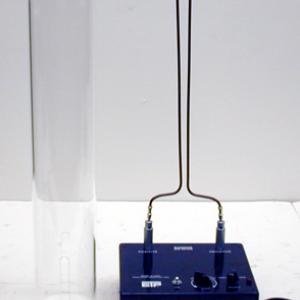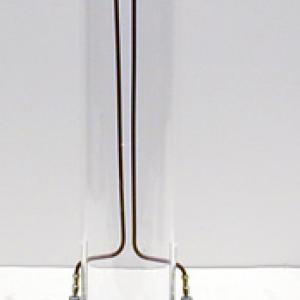College of Liberal Arts & Sciences
5D40.10 - Jacob's Ladder
Attach the antenna app. to the transformer using the insulated wires designed for this purpose. Position the gap so that the spark starts at the bottom of the antenna when the transformer is turned on. The spark should travel upward the length of the antenna if they are set correctly. Always turn off and unplug the transformer when working on it as it is putting out lethal voltages. The large plastic pipe may be placed over the antenna to keep air currents in the room from affecting the travel of the spark.
The transformer may be replaced with the induction coil. Although it is not as powerful you can still get the spark to travel 3/4 of the way up the antenna if it is adjusted properly. There is also a smaller set of antenna that may be used with the induction coil if you do not want to use the large set. A Plexiglas tube cover will help this demo immensely.
- William Gurstelle, "How To Build A Jacob’s Ladder", Popular Science, Vol. 288, #2, Mar/Apr. 2016, p. 78.
- G. D. Freier and F. J. Anderson, "Em - 3", A Demonstration Handbook for Physics.
- Julien Clinton Sprott, "4.5, Jacob's Ladder", Physics Demonstrations, ISBN 0-299-21580-6, p. 189.
- Martin C. Sagendorf, "Jacob's Ladder", Physics Demonstration Apparatus, 2009. p. 111.
- Jearl Walker, "6.3. Getting Stuck to Electric Wire", The Flying Circus of Physics with Answers.
- Sutton, Demonstration Experiments in Physics, McGraw-Hill, 1938, p. 436.
- Ron Hipschman, "Jacob's Ladder", Exploratorium Cookbook II, p. 93.1 - 93.2.
Disclaimer: These demonstrations are provided only for illustrative use by persons affiliated with The University of Iowa and only under the direction of a trained instructor or physicist. The University of Iowa is not responsible for demonstrations performed by those using their own equipment or who choose to use this reference material for their own purpose. The demonstrations included here are within the public domain and can be found in materials contained in libraries, bookstores, and through electronic sources. Performing all or any portion of any of these demonstrations, with or without revisions not depicted here entails inherent risks. These risks include, without limitation, bodily injury (and possibly death), including risks to health that may be temporary or permanent and that may exacerbate a pre-existing medical condition; and property loss or damage. Anyone performing any part of these demonstrations, even with revisions, knowingly and voluntarily assumes all risks associated with them.


